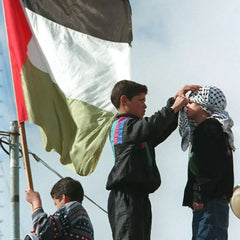Origins of the Palestinian Keffiyeh
The keffiyeh, with its distinctive black-and-white pattern, is more than just a piece of cloth, it is a powerful emblem of Palestinian heritage, resilience, and resistance. Its journey from the fields of rural Palestine to the global stage is a testament to its enduring significance.
Origins: A Symbol of Rural Life
Traditionally worn by Palestinian farmers, the keffiyeh during the Ottoman period was a marker of rural identity, distinguishing its wearers from the urban classes who donned the tarboosh (a traditional hat). For centuries, it was a practical garment, protecting farmers from the sun and dust, but it would soon take on a deeper meaning.
The Arab Revolt: A Symbol of Unity
 During the Arab Revolt of the 1930s against British colonial rule and Zionist settlement, the keffiyeh became a symbol of Palestinian nationalism. In 1938, the leadership of the revolt ordered urban Palestinians to replace their tarboosh hats with the keffiyeh. This move was not only practical, allowing rebels to blend into cities, but also symbolic, fostering unity among Palestinians of all classes. The white keffiyeh, worn by men of all ranks, became a badge of resistance and pride.
During the Arab Revolt of the 1930s against British colonial rule and Zionist settlement, the keffiyeh became a symbol of Palestinian nationalism. In 1938, the leadership of the revolt ordered urban Palestinians to replace their tarboosh hats with the keffiyeh. This move was not only practical, allowing rebels to blend into cities, but also symbolic, fostering unity among Palestinians of all classes. The white keffiyeh, worn by men of all ranks, became a badge of resistance and pride.
Post-1948: A Symbol of Resistance
After the establishment of Israel in 1948 and the displacement of hundreds of thousands of Palestinians, the keffiyeh took on new significance. It became a symbol of the Palestinian resistance movement, particularly during the 1960s. Its prominence was cemented by Yasser Arafat, the iconic Palestinian leader, who rarely appeared without his black-and-white fishnet-patterned keffiyeh. Arafat wore it in a unique style, draping it over his right shoulder to resemble the shape of historic Palestine. This distinctive look became synonymous with Arafat and the Palestinian struggle for self-determination.
Leila Khaled: A Feminist Icon in a Keffiyeh
 The keffiyeh also became a symbol of gender equality within the resistance. Leila Khaled, a member of the Popular Front for the Liberation of Palestine, famously wore the keffiyeh in the style of a hijab during the hijacking of TWA Flight 840 in 1969. Her iconic photograph, taken by Pulitzer Prize winner Eddie Adams, turned her into a global symbol of Palestinian resistance and women’s empowerment. By adopting a garment traditionally associated with Arab masculinity, Khaled challenged gender norms and inspired countless others.
The keffiyeh also became a symbol of gender equality within the resistance. Leila Khaled, a member of the Popular Front for the Liberation of Palestine, famously wore the keffiyeh in the style of a hijab during the hijacking of TWA Flight 840 in 1969. Her iconic photograph, taken by Pulitzer Prize winner Eddie Adams, turned her into a global symbol of Palestinian resistance and women’s empowerment. By adopting a garment traditionally associated with Arab masculinity, Khaled challenged gender norms and inspired countless others.
Colors and Politics
The keffiyeh’s colors also carry political significance. The traditional black&white pattern is often associated with Fatah, while the red&white keffiyeh is linked to Marxist groups like the Popular Front for the Liberation of Palestine (PFLP). In 2021, tensions flared at Al-Azhar University when Hamas security forces demanded the removal of black&white keffiyehs, highlighting the scarf’s deep political symbolism.
Global Icon: From Resistance to Runways
 Today, the keffiyeh is a global symbol, worn by activists, celebrities, and fashion enthusiasts alike. Its journey from the fields of Palestine to the streets of Paris, New York, and beyond is a testament to its universal appeal. Yet, its commercialization by top brands like Topshop and ASOS has sparked debates about cultural appropriation, reminding us that the keffiyeh is more than just a fashion trend, it is a symbol of a people’s struggle for justice and freedom.
Today, the keffiyeh is a global symbol, worn by activists, celebrities, and fashion enthusiasts alike. Its journey from the fields of Palestine to the streets of Paris, New York, and beyond is a testament to its universal appeal. Yet, its commercialization by top brands like Topshop and ASOS has sparked debates about cultural appropriation, reminding us that the keffiyeh is more than just a fashion trend, it is a symbol of a people’s struggle for justice and freedom.
A Legacy of Resistance
The keffiyeh is not just a scarf; it is a story. A story of farmers, rebels, leaders, and activists. A story of unity, resistance, and hope. Whether worn by a protester in solidarity, a politician making a statement, or a student embracing their heritage, the keffiyeh carries with it the weight of history and the promise of a free Palestine.
Visit our website to get your own kufiya and stand in solidarity with Palestine. Every purchase supports the cause and helps keep the story alive.


